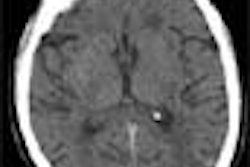For patients with emergent ischemic stroke symptoms, applying the National Institute of Neurological Disorders and Stroke (NINDS) evaluation and treatment strategy can improve outcomes and decrease costs, according to a study presented at the 2001 RSNA meeting in Chicago.
NINDS states that an emergency physician should evaluate patients within 10 minutes of their arrival in the emergency department. Neurology should be contacted within 15 minutes of the patient’s arrival; a head CT scan must be performed within 25 minutes of arrival, and read within 45 minutes.
A tissue plasminogen activator (tPA) should be given within one hour after arrival. At present, the only approved therapy for emergent ischemic stroke is intravenous tPA, which is beneficial only if given within three hours of stroke onset, said Dr. James Stahl from technology assessment firm the Data Group of Boston.
According to a literature review and meta-analysis of current practice by Stahl and his colleagues, approximately 40% of patients arrive within three hours of stroke onset. Once they arrive, an emergency physician evaluates them after an average of 25 minutes, or 0.41 hours, and they receive tPA at 97 minutes, or 1.6 hours, after arriving in the emergency room.
Stahl told AuntMinnie.com that these statistics "are not what they should be." However, "physicians being constrained to do no harm must determine first whether or not the stroke that the patient is having is ischemic," he added. "Most patients arrive at the (emergency department) very close to the time limit when therapy may be effective. It is a race between physicians and disease in which the disease has been given a big head start."
Using a stochastic discrete events simulation, the authors compared current practice and the NINDS strategy for a population of 250,000 over one year. They looked at the quality-adjusted life-year (QALY), the cost, and the relative cost-effectiveness of one strategy versus another.
The study’s stroke evaluation and management model encompassed stroke care from symptom onset, through emergency-department arrival, through evaluation by emergency physician, CT scanning, and the administration of tPA in eligible patients. The researchers assumed that the process was essentially linear from onset to treatment -- except when neurologists were called on an as-needed basis.
The timing and cost data were derived from a systematic review of the literature, expert opinion, and hospital databases when no other sources were available.
Outcomes were determined based on the number of patients treated within the three-hour therapeutic window and the number of patients expected to show symptomatic improvement.
The study was based on several assumptions: Each emergency room had access to one CT scanner; three neurologists were available either on-call or in-house; there was sufficient ER and radiology staff to manage patient volume; and that the NINDS-compliant strategy had similar administrative costs as current practice.
Finally, the researchers assumed that strokes occurred at a rate of 11.3 per 1,000 people per year based on Centers for Disease Control statistics.
The time between stroke onset and treatment was 3.5 hours for the base case, versus 2.58 hours for the NINDS-compliant strategy. The latter also reduced time from patient arrival to evaluation by the ER doctor by 0.23 hours, and from arrival to the CT scan by 1.61 hours. The mean reduction in time from arrival to treatment was 1.89 hours with NINDS.
In the base case, the estimated annual cost was $13.1 million. The number of patients treated within the three-hour therapeutic window was 61, and the number of patients expected to show symptomatic improvement with tPA was 13.
In the NINDS-compliant scenario, the cost was $13.5 million. Two hundred twenty patients were treated within the three-hour window, and 63 improved symptomatically with tPA.
Stahl and colleagues found that the total societal cost per patient in current practice is approximately $6,809 for every 3.629 QALY gained. NINDS-compliant strategy cost $6,702 per patient for every 3.675 QALY gained. The NINDS strategy remains preferable to current practice for volumes less than or equal to 100 patients per CT scanner per day.
When the researchers examined the effect of varying several key parameters through sensitivity analysis, such as the time between stroke onset to emergency department arrival, the NINDS strategy was still preferable to current practice.
"The NINDS strategy remained cost-saving up to spending an additional $1,500 per patient," Stahl said.
As the study analyzed the system of care delivery and not the therapy itself, costs and QALY were spread over the whole population presenting with stroke -- those who received tPA and those who arrived too late for tPA administration.
"The net gain for individual patients is substantially greater," Stahl said.
By Leslie FarnsworthAuntMinnie.com contributing writer
January 9, 2002
Related Reading
MRI identifies patients at risk of hemorrhagic transformation after stroke, April 23, 2001
Computer program assesses reinfarction risk in acute stroke patients, April 8, 2001
Dynamic CT perfusion data may help widen window for stroke treatment, August 28, 2000
Copyright © 2002 AuntMinnie.com



















